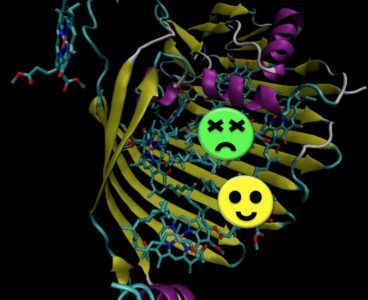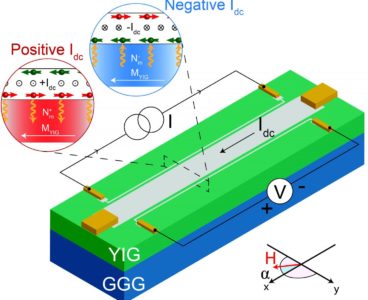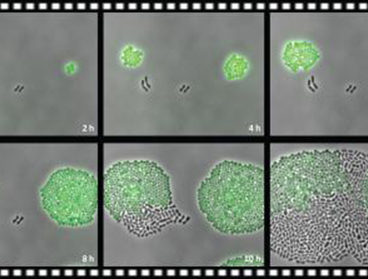Scientists of the University of Groningen have developed nanopores that can be used to directly measure the mass of peptides. Although the resolution needs to be improved, this proof of principle shows that a cheap and portable peptide mass spectrometer can be constructed using existing nanopore technology and the patented pores that were developed in…
First Transport Measurements Reveal Germanene’s Curious Properties
Germanene is a 2D material that derives from germanium and is related to graphene. As it is not stable outside the vacuum chambers in which is it produced, no real measurements of its electronic properties have been made. Scientists led by Professor Justin Ye, Associate Professor of Device Physics at the University of Groningen, have…
Understanding the Building Blocks for an Electronic Brain
Computer bits are binary, with a value of 0 or 1. By contrast, neurons in the brain can have all kinds of different internal states, depending on the input that they received. This allows the brain to process information in a more energy-efficient manner than a computer. University of Groningen (UG) physicists are working on…
Single Molecules from Blood Measured in Real Time
University of Groningen scientists, led by Associate Professor of Chemical Biology Giovanni Maglia, have designed a nanopore system that is capable of measuring different metabolites simultaneously in a variety of biological fluids, all in a matter of seconds. The electrical output signal is easily integrated into electronic devices for home diagnostics. The results were published…
Defects Promise Quantum Communication Through Standard Optical Fiber
An international team of scientists led by the University of Groningen’s Zernike Institute for Advanced Materials has identified a way to create quantum bits that emit photons that describe their state at wavelengths close to those used by telecom providers. These qubits are based on silicon carbide in which molybdenum impurities create color centers. The…
Graphene Bilayer Transports, Controls Spin
University of Groningen physicists in collaboration with a theoretical physics group from Universität Regensburg have built an optimized bilayer graphene device that displays both long spin lifetimes and electrically controllable spin-lifetime anisotropy. It has the potential for practical applications such as spin-based logic devices. The results were published in Physical Review Letters. Miniaturizing the elements…
Quantum Effects Observed in Photosynthesis
Molecules that are involved in photosynthesis exhibit the same quantum effects as non-living matter, concludes an international team of scientists including University of Groningen theoretical physicist Thomas la Cour Jansen. This is the first time that quantum mechanical behavior was proven to exist in biological systems that are involved in photosynthesis. The interpretation of these…
Creating a 2D Platinum Magnet
University of Groningen physicists have induced magnetism in platinum with an electric field created by a paramagnetic ionic liquid. As only the surface of the platinum is affected, this creates a switchable 2D ferromagnet. The study was published in Science Advances on 6 April. Platinum is used a lot in jewellery and electronics. Although this precious metal…
Shedding Light on the Mystery of the Superconducting Dome
University of Groningen physicists, and colleagues from Nijmegen and Hong Kong, have induced superconductivity in a monolayer of tungsten disulfide. By using an increasing electric field, they were able to show how the material turns from an insulator into a superconductor and then back into a ‘re-entrant’ insulator again. Their results show the typical ‘dome-shaped’…
Practical Spin Wave Transistor One Step Closer
University of Groningen physicists have managed to alter the flow of spin waves through a magnet, using only an electrical current. This is a huge step towards the spin transistor that is needed to construct spintronic devices. These promise to be much more energy efficient than conventional electronics. The results were published on 2 March…
New Metal-Semiconductor Interface for Brain-Inspired Computing
Brain-Inspired Computing from Breakthrough Semiconductor Interface
One of the big challenges in computer architecture is integrating storage, memory, and processing in one unit. This would make computers faster and more energy efficient. University of Groningen physicists have taken a big step towards this goal by combining a niobium doped strontium titanate (SrTiO3) semiconductor with ferromagnetic cobalt. At the interface, this creates…
Solar Cells Improved by Slow, Hot Electrons
Photons with energy higher than the “band gap” of the semiconductor absorbing them give rise to what are known as hot electrons. The extra energy in respect to the band gap is lost very fast, as it is converted into heat so it does not contribute to the voltage. University of Groningen Professor of Photophysics…
Reality Check for ‘Wonder Material’
Topological insulators, a class of materials which has been investigated for just over a decade, have been heralded as a new ‘wonder material,’ as has graphene. But so far, topological insulators have not quite lived up to the expectations fueled by theoretical studies. University of Groningen physicists now have an idea about why. Their analysis…
Antibiotic Resistance Just Became More Complex
Bacteria that are susceptible to antibiotics can survive when enough resistant cells around them are expressing an antibiotic-deactivating factor. This new take on how the microbial context can compromise antibiotic therapy was published by a team of microbiologists from the University of Groningen microbiologists, together with colleagues from San Diego, in the journal PLOS Biology on 27…
Antibiotic Resistance Just Became More Complex
Bacteria that are susceptible to antibiotics can survive when enough resistant cells around them are expressing an antibiotic-deactivating factor. This new take on how the microbial context can compromise antibiotic therapy was published by a team of microbiologists from the University of Groningen microbiologists, together with colleagues from San Diego, in the journal PLOS Biology on 27…









